MENU
STIDS 2012 Home
About--
Topic list
Program Committee
Venue & Local info
Registration
Sponsors
Program--
Keynote Speakers
Tutorial
Agenda & Papers
Proceedings
Call for Papers
Important dates
Submission details
Download CFP
Attendees
C4I
Home

SEMANTIC
TECHNOLOGY FOR
INTELLIGENCE,
DEFENSE, AND
SECURITY
Tuesday, October 23, 2012
Faculty: Barry Smith, Tanya Malyuta, William Mandrick and Lowell Vizenor
The goal of this tutorial is to provide a general introduction to ontology tools and methods, and to show how an ontology-based strategy is being applied within a military program of record for retrieval and analysis of intelligence data. We show how this strategy defines a repeatable process for ontology creation, and describe how this process is being applied in other military domains. |
|||
| 09: 00 - 09:50 | Registration / Breakfast | ||
| 09: 50 - 11:20 | Semantic Technology: A Basic Introduction (Lowell Vizenor) |
||
|
Topics
The underlying idea of the Semantic Web and Linked Data |
|||
| 11: 20 - 11:40 | Break | ||
| 11:40 - 12:20 | What is an Ontology and What is it Useful for? (Barry Smith) |
||
|
Topics
Failures and successes of semantic technology |
|||
| 12:20 - 12:55 | A Strategy for Military Ontology (William Mandrick) |
||
|
Topic
A repeatable process for building ontologies in the military domain
|
|||
| 12:55 - 13:50 | Lunch Break |
||
| 13:50 - 14:50 | A Strategy for Intelligence Ontology (Barry Smith and Tanya Malyuta) |
||
|
Topic
The Army DSC Cloud project for Semantic Enhancement of intelligence data |
|||
| 14:50 - 15:10 | Break |
||
| 15:10 - 16:40 | Realizing the Strategy: a practical introduction to ontology building (Barry Smith and William Mandrick) |
||
|
Examples
Core example: General Military Ontology (GMO) |
|||
| 16:40 - 17:00 | Wrap-Up |
||
| 17:00 | Close |
||
Tatiana Malyuta, PhD, is Principal Data Architect and Researcher at Data Tactics Corporation and an Associate Professor of the New York College of Technology of CUNY. She is a subject matter expert in data design and data integration. Recently she has been working on integrated data stores on the Cloud within the context of the Army's Distributed Common Ground System (DCGS-A).
William Mandrick, PhD, is a Senior Ontologist at Data Tactics Corpration and an Adjunct Professor at the University at Buffalo. He is also a Lieutenant Colonel in the U.S. Army Reserves with deployments to Iraq and Afghanistan where he has commanded soldiers, planned for major operations, and served as the primary civil-military operations advisor to a Brigade Combat Team. Recently he has been working on intelligence related ontologies for the Intelligence and Information Warfare Directorate (I2WD).
Barry Smith, PhD, is an internationally recognized leader in the field of ontology and semantic technology. He is Professor of Philosophy, Neurology, and Computer Science and Engineering at the State University of New York at Buffalo. Smith is Director of the National Center for Ontological Research, the founder of the Ontology for the Intelligence Community (now STIDS) conference series, and organizer of multiple conferences and training events in ontology and its applications.
Lowell Vizenor, PhD, is Ontology and Semantic Technology Practice Lead for Alion Science and Technology and is currently supporting the NextGen Air Transportation Joint Planning and Development Office Net-Centric Operations Division in the role of Lead Semantic Architect. He has over 10 years experience developing and implementing semantic solutions for industry, government and academia.
Tuesday, October 23, 2012
Faculty: Amanda Vizedom, Simon Spero, Beth Huffer
This pragmatic tutorial is designed those who manage semantic technologies projects, supervise contracts involving semantic technologies, or advocate the introduction of semantic technologies within their organizations. Our goal is to give participants knowledge and tools for successful management and avoidance of common failures and risk factors. We will provide an overview of some tools, methods, and lessons learned. Topics covered will include identifying and specifying requirements, staffing up, measuring progress, and quality control. Cross-cutting themes will include warning signs, common mistakes, and getting back on track, key vocabulary and things you should know about it as a manager, distinguishing the important from the unimportant, common distractions. |
|||
| 09:00 - 09:50 | Registration / Breakfast | ||
| 09:50 - 10:30 | Know what you need, Part I: Ontologies, Controlled Vocabularies & their Kin |
||
|
Topics
|
|||
| 10:30 - 11:20 | Know what you need, Part II: Applications and Use Cases |
||
|
Topics
|
|||
| 11:20 - 11:40 | Break | ||
| 11:40 - 12:20 | Know who you'll need: The right kinds of technical personnel, subject matter experts, and others |
||
|
Topics
|
|||
| 12:20 - 12:55 | What (not) to ware: Modeling tools, reasoners, storage, interfaces, and other infrastructure |
||
|
Topic
|
|||
| 12:55 - 13:50 | Lunch Break |
||
| 13:50 - 14:50 | Getting on track and staying there: Requirements, development cycles, evaluation and testing |
||
|
Topic
|
|||
| 14:50 - 15:10 | Break |
||
| 15:10 - 15:40 | Getting just what you need: Separating Wheat, Chaff, and Snow |
||
|
Topics
|
|||
| 15:40 - 16:20 | Opportunity and effect multipliers: Sharing what you should; writing for reuse; meeting user needs; reducing future costs; working with others |
||
|
Topics
|
|||
| 16:20 - 17:00 | Open Discussion and Wrap-Up |
||
| 17:00 | Close |
||
Beth Huffer, M.A., is an Information Architect specializing in the design and development of ontology-supported systems, and owner of Lingua Logica. She has extensive experience as an applied ontologist, a Director-level technical manager, an information architect, and a program manager for semantic technology projects, both government and private.
Simon E Spero, Bsc.Eng, ACGI is a Senior Developer at Criticollab. He has extensive experience with the full lifecycle of large enterprise core systems, along with expertise in semantic technology applications for digital curation and in secure, sustainable, and survivable semantically enabled systems.
Amanda Vizedom, PhD, is Principal Ontologist at Wind River Consulting. She has developed ontologies, lead ontology teams, lead cross-functional research and development teams, and managed cross-functional semantic technology projects in both private sector and government contexts.
